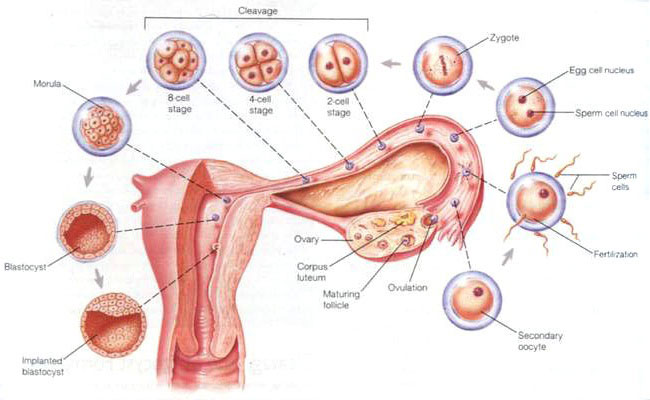The Reproductive System of a woman The Menstrual Cycle The Hormones The Reproductive System of a Man The Role of Testosterone The Sperms Odyssey in the Female Reproductive Tract The Process of FertilisationThe Reproductive System of a Man The male reproductive system begins in the scrotum, the sack behind the penis. This contains two testicles, which make mens sex cells, called sperm; and the male sex hormone, called testosterone. The testicles feel solid, but a little spongy, like hard boiled eggs without the shell. They hang from a cord called the spermatic cord. Its normal for one testicle to hang lower than the other; and for one testicle to feel slightly larger than the other. The testicles make sperm best at a temperature a few degrees cooler than normal body temperature. This is why nature designed a scrotum - so that the testes can hang outside the body to keep them cool. The testicles start making sperm when a young man reaches puberty. This is in response to the male sex hormone, testosterone, which starts being produced at this time. The testes keep making sperm for the rest of the mans life. The sperms are produced inside several hundred coiled microscopic tubules called seminiferous tubules in the testes. These tubules converge and collect into a delta (like the mouth of a river) near the upper part of the testis called the rete testis which then empties through a series of very small ducts out of the testis towards the epididymis. The epididymis is an amazing structure - it is a very long tiny tubule, which runs back and forth in convolutions and loops to form a tiny compact structure with a head, body and tail that sits like a cap on the top of and behind the testis. The tail of the epididymis then leads to the vas deferens - a thin cord like muscular tube, which is part of the spermatic cord and which ends at the ejaculatory duct in the prostate. Here is joined by the seminal vesicle ducts and they all open into the prostatic part of the urethra - which in turn leads to the urethra in the penis. Mature sperm take about 75 days to develop in a process called spermatogenesis. Sperm production takes place as though it were on an assembly line - with the more mature sperms being passed along toward the center of the tubule from where they swim towards the efferent ducts of the testis towards the epididymis. This can be a very "temperamental" assembly line - things often go wrong, causing low sperm counts. When the sperm leave the testis, they are not yet able to swim on their own. They acquire the capacity to do so in their passage through the epididymis - which is like a swimming school for the sperm. They spend between 2 to 15 days here during which they attain maturity and fertilising potential. Sperm are propelled along this tunnel by frequent contractions of its thin muscular wall. Most of the mature sperm are then stored at the end of the epididymis - where they wait to be rushed through the vas deferens and ejaculated at the time of orgasm. During ejaculation, the epididymis and vas deferens muscles contract to propel the sperm into the ejaculatory duct. Here the sperm is joined with the secretions of the seminal vesicles and prostate gland (which contribute the bulk of the seminal fluid) to form the semen. The powerful muscles surrounding the base of the urethra then cause the semen to squirt out of the penis at the time of orgasm. Semen and urine never mix in a healthy male ( even though the final passage for both is common) because the bladder sphincter muscle contracts during sexual stimulation, thus closing down the exit from the bladder to the urethra during ejaculation - preventing urine from leaking forward out of the bladder during sex and also preventing semen from accidentally going backward into the bladder. What about the penis and fertility? Most men equate their fertility potential with their virility - and therefore the size of their penis. However, the size of the penis has little to do either with fertility potential or with sexual ability. (In any case, if you worry that your penis is too small, youre not alone - most men think their penises are too small !) During ejaculation, about one teaspoon of semen spurts out of the penis. Semen is a milky white color, the consistency of egg white. Sperm account for only about 2 to 3% of semen. Most of it consists of seminal fluid - the secretion of the seminal versicles and the prostate gland, which provide a vehicle for the sperm into the vagina. A normal ejaculation contains 200 to 500 million sperm. How can so many sperm fit into only a teaspoon of semen? Simple - sperm are very tiny. If one average ejaculation filled an Olympic size swimming pool, each sperm cell would still be smaller than a goldfish. Sperms are the smallest living cells in the human body - and the egg the largest. Basically, sperms are designed so that they can deliver their contents - the male genetic material - to the egg. This is why they are designed like projectiles - the male DNA is in the chromosomes in the sperm head nucleus, and the tail propels the sperm up towards the egg. Sperm are also very fragile. Men make so many because very few survive the swim through the female reproductive system to fertilize an egg. Perhaps the reason for this is an evolutionary hangover. Female fish deposit eggs on the sea-bed. This is why male fish need to produce millions of sperm which are sprayed into the sea water where millions will be wasted in order to ensure that some reach the eggs. What happens to the sperms if you dont have sex for many days? Unfortunately, you cannot "store up" sperms. If ejaculation does not occur for many days, the sperms in the reproductive ducts simply die. This is why a sperm count done after many days of abstinence shows a high number of dead or immotile sperms. But just like you cannot store your sperm, you cannot run out of sperm either - masturbation and sex cannot use sperm up. The body keeps making sperm as long as a man has even one normal testicle.
The Reproductive System of a woman The Menstrual Cycle The Hormones The Reproductive System of a Man
The Role of Testosterone The Sperm's Odyssey in the Female Reproductive Tract The Process of FertilisationThe Reproductive System of a Man
The male reproductive system begins in the scrotum, the sack behind the penis. This contains two testicles, which make men's sex cells, called sperm; and the male sex hormone, called testosterone. The testicles feel solid, but a little spongy, like hard boiled eggs without the shell. They hang from a cord called the spermatic cord. It's normal for one testicle to hang lower than the other; and for one testicle to feel slightly larger than the other.
The testicles make sperm best at a temperature a few degrees cooler than normal body temperature. This is why nature designed a scrotum - so that the testes can hang outside the body to keep them cool.
The testicles start making sperm when a young man reaches puberty. This is in response to the male sex hormone, testosterone, which starts being produced at this time. The testes keep making sperm for the rest of the man's life.
The sperms are produced inside several hundred coiled microscopic tubules called seminiferous tubules in the testes. These tubules converge and collect into a delta (like the mouth of a river) near the upper part of the testis called the rete testis which then empties through a series of very small ducts out of the testis towards the epididymis. The epididymis is an amazing structure - it is a very long tiny tubule, which runs back and forth in convolutions and loops to form a tiny compact structure with a head, body and tail that sits like a cap on the top of and behind the testis. The tail of the epididymis then leads to the vas deferens - a thin cord like muscular tube, which is part of the spermatic cord and which ends at the ejaculatory duct in the prostate. Here is joined by the seminal vesicle ducts and they all open into the prostatic part of the urethra - which in turn leads to the urethra in the penis.
Mature sperm take about 75 days to develop in a process called spermatogenesis. Sperm production takes place as though it were on an assembly line - with the more mature sperms being passed along toward the center of the tubule from where they swim towards the efferent ducts of the testis towards the epididymis. This can be a very "temperamental" assembly line - things often go wrong, causing low sperm counts.
When the sperm leave the testis, they are not yet able to swim on their own. They acquire the capacity to do so in their passage through the epididymis - which is like a swimming school for the sperm. They spend between 2 to 15 days here during which they attain maturity and fertilising potential. Sperm are propelled along this tunnel by frequent contractions of its thin muscular wall. Most of the mature sperm are then stored at the end of the epididymis - where they wait to be rushed through the vas deferens and ejaculated at the time of orgasm.
During ejaculation, the epididymis and vas deferens muscles contract to propel the sperm into the ejaculatory duct. Here the sperm is joined with the secretions of the seminal vesicles and prostate gland (which contribute the bulk of the seminal fluid) to form the semen. The powerful muscles surrounding the base of the urethra then cause the semen to squirt out of the penis at the time of orgasm. Semen and urine never mix in a healthy male ( even though the final passage for both is common) because the bladder sphincter muscle contracts during sexual stimulation, thus closing down the exit from the bladder to the urethra during ejaculation - preventing urine from leaking forward out of the bladder during sex and also preventing semen from accidentally going backward into the bladder.
What about the penis and fertility? Most men equate their fertility potential with their virility - and therefore the size of their penis. However, the size of the penis has little to do either with fertility potential or with sexual ability. (In any case, if you worry that your penis is too small, you're not alone - most men think their penises are too small !)
During ejaculation, about one teaspoon of semen spurts out of the penis. Semen is a milky white color, the consistency of egg white. Sperm account for only about 2 to 3% of semen. Most of it consists of seminal fluid - the secretion of the seminal versicles and the prostate gland, which provide a vehicle for the sperm into the vagina.
A normal ejaculation contains 200 to 500 million sperm. How can so many sperm fit into only a teaspoon of semen? Simple - sperm are very tiny. If one average ejaculation filled an Olympic size swimming pool, each sperm cell would still be smaller than a goldfish. Sperms are the smallest living cells in the human body - and the egg the largest. Basically, sperms are designed so that they can deliver their contents - the male genetic material - to the egg. This is why they are designed like projectiles - the male DNA is in the chromosomes in the sperm head nucleus, and the tail propels the sperm up towards the egg.
Sperm are also very fragile. Men make so many because very few survive the swim through the female reproductive system to fertilize an egg. Perhaps the reason for this is an evolutionary hangover. Female fish deposit eggs on the sea-bed. This is why male fish need to produce millions of sperm which are sprayed into the sea water where millions will be wasted in order to ensure that some reach the eggs.
What happens to the sperms if you don't have sex for many days? Unfortunately, you cannot "store up" sperms. If ejaculation does not occur for many days, the sperms in the reproductive ducts simply die. This is why a sperm count done after many days of abstinence shows a high number of dead or immotile sperms. But just like you cannot store your sperm, you cannot run out of sperm either - masturbation and sex cannot use sperm up. The body keeps making sperm as long as a man has even one normal testicle.






























